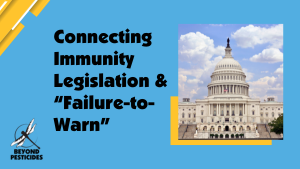11
Apr
As Artificial Intelligence Gains Momentum with Dramatic Promises, Bioethicists Call for Regulation
(Beyond Pesticides, April 11, 2025) In a new report by Save our Seeds/Foundation on Future Farming, a consortium of EU-based scientists and bioethicists raise concerns about the implications and threats of generative artificial intelligence (GAI) for genetic engineering. Artificial intelligence will impact all aspects of society, including the acceleration of genetic editing tools that may lead to increased risks of harmful traits/genetic data being incorporated into products on the global marketplace. Organic farmers, conservationists, and public health professionals who collaborate with Beyond Pesticides grow increasingly concerned about the long-term impacts of deregulation and ongoing federal funding freezes and firings on needed regulatory oversight of the tech sector, including AI.
Review of Save our Seeds Report
So, what is artificial intelligence (AI)?
AI is a broad field that focuses on building machines and systems that can think, learn, and solve problemsâincorporating elements of human behavior. It powers things like voice assistants, self-driving cars, and recommendation systems on apps like Netflix or Spotify. In short, AI is designed to understand information, make decisions, and complete tasks intelligently.
Generative AI, however, is an extension of AI focused on creativity. The main goal is to generate new contentâwhether in writing, photography, video, music, or computer code. Tools like ChatGPT and DALL·E can produce original stories, artwork, or designs based on the inputted information. While traditional features of AI were designed to support summation, light analysis, and automation, generative AI imagines and invents new content. The allegory that comes to mind is AI as the problem-solver and generative AI as the creator.
The integration of generative artificial intelligence (AI) into the genetic engineering of biological life is transforming the agribusiness sector. Developers have adapted AI architectures from models to interpret biological “languages,” given the sweeping quantity of gathered data on plant DNA, RNA, proteins, and metabolites in recent years. As a result, AI tools have become both descriptive and generative, capable of analyzing and summarizing datasets, proposing predictions, and designing functional DNA, RNA, and protein sequences, including ânew-to-nature” sequences.
Depending on the genetic data entered, AI models can fall into at least four categories highlighted by the authors of this report:
- Protein Models: These models can analyze proteins, simulate their interactions, and redesign their functions. Notably, Google’s AlphaFold has made significant contributions to this field, earning recognition for its advancements.
- DNA Models: Since 2021, large language models trained on DNA sequences have been developed. Among them, AgroNT, a collaboration between Google and Instadeep released in late 2023, stands out for being trained on 10 million genome sequences from 48 plant species.
- RNA Models: While AI models trained on human RNA sequences exist, it is anticipated that plant-based RNA models will be developed soon, with models like scGPT based on single-cell RNA sequencing data. Scientists writing on ScGPT last year in Nature said, âOur findings illustrate that scGPT effectively distills critical biological insights concerning genes and cells.â
- Multimodal Models: Developers are now working on multimodal AI systems capable of processing multiple forms of biological data, integrating DNA, RNA, and protein data for comprehensive analysis.
CRISPR-Cas remains foundational to gene editing, and developers have modified existing and new AI tools to optimize this process. These tools assist researchers in identifying optimal genetic targets, suggesting effective sequences to guide RNA, and selecting suitable CRISPR-cutting enzymes as a means to what the authors refer to as an increase in the precision and efficiency of gene editing. The use of AI has also expanded CRISPR’s capabilities to include quantitative trait engineering, permitting the control of gene expression levels and the potential to influence complex quantitative traits. Gene expression is pivotal to understanding why some are more likely to be diagnosed with cancer, but also the basics of cell structures.
âLarge seed companies such as Corteva, Bayer, BASF, and Syngenta are increasingly using AI tools in their genetic engineering programmes,â according to the authors in this report on agrichemical corporationsâ infiltration into the space. They continue: âTo complement their in-house AI expertise, these companies are also partnering with specialised firms. For instance, BASF and Corteva have initiated collaborations with Tropic Biosciences, which owns proprietary AI technology. Syngenta has teamed up with Instadeep and Biographica, while Bayer is supporting startups Ukko and Amfora, both of which combine AI and CRISPR technologies to develop new plant varieties.â
On the one hand, proponents of its use argue that AI enhances the precision and efficiency of CRISPR-based gene editing, expanding its capabilities beyond traditional gene knockouts (an alteration in the genome resulting in reduced or eliminated function of a protein (genetic alteration that results in a reduced or abolished function of a protein, RNA, or other genetic products; see Oxford University definition here.)
However, the report highlights four critical, non-exhaustive vulnerabilities of existing AI in the realm of genetic engineering, including:
âLower skill thresholdâ conundrum
Generative AI significantly lowers the barrier to entry for performing complex genetic engineering tasks. While this could democratize plant building by reducing infrastructure and technology costs, it also opens the door to lower quality science, as individuals without adequate scientific trainingâsuch as students or “DIY biologistsâ âmight accidently create or release genetically modified/engineered biomaterial with unpredictable or hazardous traits without regulators even knowing where to look. This could happen even by those with extensive scientific training.
The black box effect
Generative AI models typically operate as “black boxes”âthe tools provide new content without revealing the rationale underpinning the decision-making process. This lack of transparency is particularly dangerous in genetic engineering, where unintended biological consequences can go easily unnoticed, threatening biodiversity, public health, and climate resilience.
Data hallucinations
Generative AI is capable of producing palatable, yet factually invalid or irrelevant results, known as âhallucinations.â In the context of genetic engineering, these inaccuracies could lead to faulty designs or misinformed decisions, which in turn could lead to the development of GE plants with harmful traits being developed and released into ecosystems and on farmland, public lands, and other forms of private property.
Data distortions
AI systems, generative and otherwise, tend to rely on large datasets for training their models to produce original content. If these sets contain errors or biases, whether from the complexity of the biological systems genetic scientists are aspiring to emulate or basic human error, methodological or otherwise, the resulting predictions may also be skewed.
The overarching concern emerging from this report is the risk that plants with undesirable traits could be engineered and released into the environment prematurely, without proper regulatory or scientific oversight to account for potential errors.
Artificial Intelligence: Friend or Foe to Organic?
There is significant literature (see studies below) on the role of AI and machine learning to âoptimizeâ or âreduceâ the use of pesticides, which enables the petrochemical pesticide industry to continue business as usual. There are also misconceptions about organic that may threaten its integrity in the long-term, such as a study published by researchers at Oxford University and Sher-e-Kashmir University of Agricultural Sciences and Technology of Kashmir, who call for the use of AI to enable consumers with a âa âthirdâ choice and create a new food label, âorganically-grown GM produceâ.â
However, there are also a series of studies from research institutions across the globe emphasizing the importance of AI in fixing capacity gaps in organic agriculture, be it from the perspective of soil health data gathering in European Union and Morocco-based research studies or protecting product integrity by mitigating fraud, discussed in a study published in 2024 by researchers at the Institute for Global Food Security. There is also the potential to employ AI and machine-learning tools (e.g., drones, sensors), it is argued, to address other issues that organic farmers face, such as tracking pesticide drift from off-site sources through sensors, a potential remedy to ensure adherence to standards, real-time pest monitoring and management tools accessible from a phone, and AI projections of weather and climatological data, soil moisture levels, crop health monitoring, and other data aggregation that could render toxic pesticide use unnecessary.
Call to Action
Organic advocates and farmers view federal decision-making as inadequate to protect against GE contamination and subsequent health risks. There is a bipartisan consensus in Washington to promote genetic engineering, made evident in the Biden Administration-published report that promotes genetic engineering, âThe Coordinated Framework for the Regulation of BiotechnologyâPlan for Regulatory Reform under the Coordinated Framework for the Regulation of Biotechnology,â which followed efforts of previous administrations going back to the Clinton Administration. (See Daily News here.)
The issue of genetic engineering spans beyond the concern of food production. In 2022, U.S. Environmental Protection Agency (EPA) approved the introduction of millions of GE mosquitoes in California and Florida (see Daily News here) alongside the continuous use of prophylactic synthetic insecticide spraying (including sumithirin and bifenthrin) amid outbreaks of deadly arborviruses, such as West Nile and Eastern Equine Encephalitis (see Beyond Pesticides press release here and associated Action of the Week here), which exacerbates insect and weed resistance to toxic chemicals and pesticides.
Policymakers in countries like Kenya and Mexico are standing up to this threat by implementing the precautionary principle into legislative and regulatory decision-making. Just last month, the Mexican legislature signed into law a constitutional amendment prohibiting GE seeds, a direct rebuke to ongoing trade threats and attacks by the Trump Administration. See the recent Daily News post, Mexico Rejects U.S. Forcing Genetically Engineered Corn on Country under Trade Agreement, for analysis of the nearly 2,000-page scientific dossier underpinning the nationâs decision to prohibit GE corn and glyphosate use.
The Spring 2025 meeting for the National Organic Standards Board is a time for the public to speak out on the future of the U.S. food system. The meeting will be held virtually from April 29 to May 1. Written comments are due by April 28, with public comment webinars scheduled for April 22 to April 24 from 12-5pm EDT. See this week’s Action of the Week to submit public comments (see Daily News here) and our Keeping Organic Strong webpage to stay updated on how to engage in the public comment process to strengthen integrity in organic standards!
All unattributed positions and opinions in this piece are those of Beyond Pesticides.
Source: Save Our Seeds










 State legislation to quash lawsuits against chemical manufacturers because of their âfailure to warnâ about the hazards of their pesticide products is moving forward in six state legislatures (
State legislation to quash lawsuits against chemical manufacturers because of their âfailure to warnâ about the hazards of their pesticide products is moving forward in six state legislatures ( Through grassroots efforts, coalitions and communities across the nation have successfully beat back this legislation in Mississippi, Wyoming, Montana, and Oklahoma this year after a successful defense in Missouri, Idaho, and Iowa in the 2024 legislative session. The publicâs voice is pivotal at this time!
Through grassroots efforts, coalitions and communities across the nation have successfully beat back this legislation in Mississippi, Wyoming, Montana, and Oklahoma this year after a successful defense in Missouri, Idaho, and Iowa in the 2024 legislative session. The publicâs voice is pivotal at this time! Dr. Gussow delivered a
Dr. Gussow delivered a 
